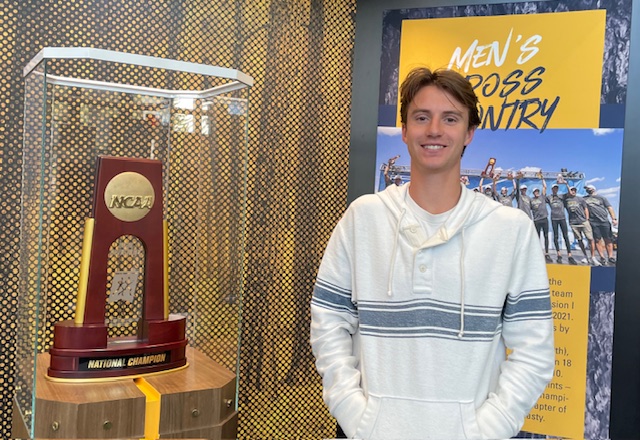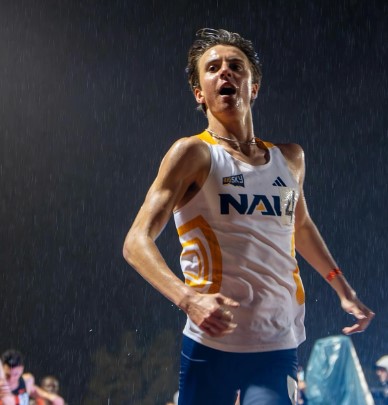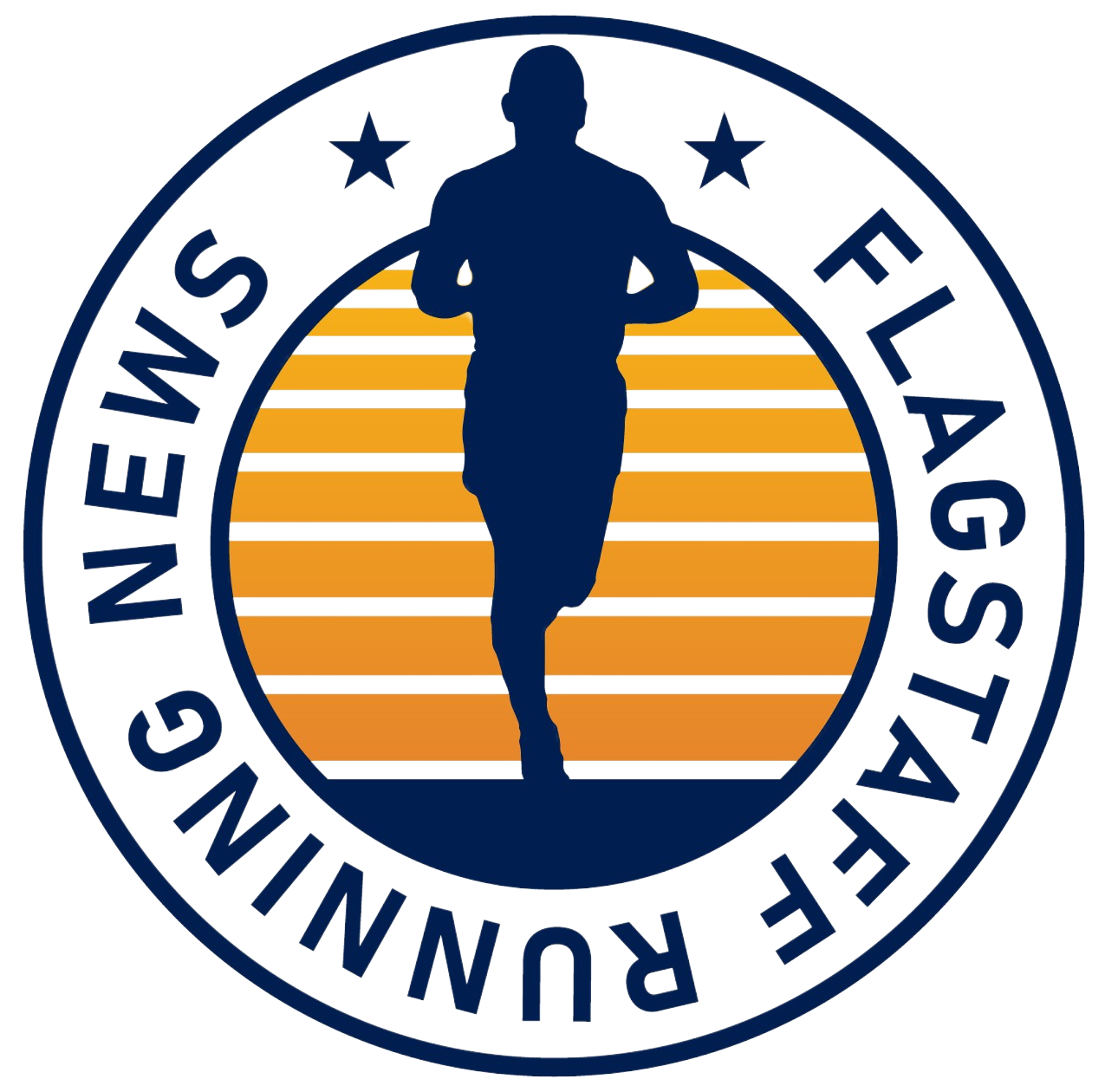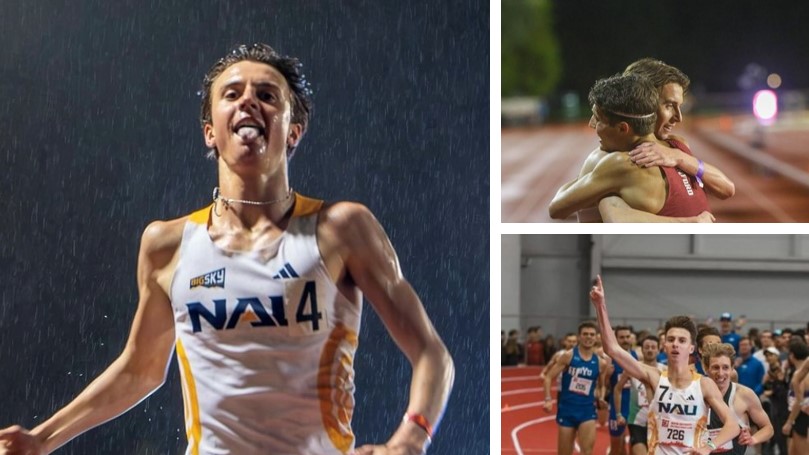When he wins a race – and, lately, that’s become a common occurrence – Colin Sahlman can get a bit animated.
Breaking the tape at an indoor mile in Boston in January, the NAU sophomore thrust up his right arm, index finger extended, to celebrate his 3:53.17 victory. At the Stanford Invitational last month, having just won the 5,000 meters in 13:38.96, he turned and embraced his former high school teammate, Leo Young. And, two weeks ago at the Bryan Clay Invite, completing the second fastest 1,500-meter time (3:33.96) in NCAA history, Sahlman stuck out his tongue, either from relief or fatigue or perhaps a combination.
You might look at these finish-line celebrations and come away thinking: here’s a runner with supreme confidence who is not afraid to show it, who punctuates his top performances with a message to either himself or the running world in general.
What you don’t see is the Sahlman who was, until recently, was dealing with an unprecedented feeling of self-doubt, who coped with unbelievable expectations weighing him down, who noticed that the very people who once praised him as the future of distance running on a notorious online message board had now summarily dismissed him.
Gee, washed up at age 20. Too bad. Dude peaked in high school. A real shame.
Now, Sahlman can chuckle at the criticism he faced the past year and a half at NAU, after a celebrated high school career at Newbury Park in which he was named Gatorade’s National Athlete of the Year (encompassing all sports). Now, he can point to the sky – and to his results – to silence those critics, many being the same ones who now, after his Bryan Clay performance, have jumped back on the bandwagon and hype his Olympic 1,500-meter prospects and wonder when he might turn pro.
Though he gives a slight shake of his head, Sahlman betrays little emotion behind those Ray Ban aviator sunglasses he’s wearing on the patio outside NAU’s new Sports Performance Center on a sunny spring morning. If anything, the vibe he exudes now is more humility than hubris.
He has learned much in his first two years at NAU.
About patience. About focus. About delayed gratification. About keeping perspective.
Sahlman is not the first celebrated prep star to initially struggle in college, and he most assuredly won’t be the last. But he, like teammate Nico Young before him, has been forced to come-of-age in an intense social-media spotlight. And, also like Young, he is starting to emerge on the other side having lived up to expectations, his and others’.
He now is a favorite, alongside defending champ Nathan Green of Washington and Wisconsin’s Adam Spencer, to contend for the NCAA 1,500 title in June, and there’s even talk that he can seriously challenge Yared Nuguse, Hobbs Kessler, and Cole Hocker for a U.S. Olympic berth.

It has not been easy, though, securing his spot in the middle-distance firmament.
Sahlman has not only had to gain strength in his body, but also in his mental approach. That psychological maturation may account just as much, if not more, than learning tactics and improving his form for his ascension to elite status, first in the just-concluded indoor season and now outdoors.
Credit Coach Mike Smith and NAU’s mental performance specialist Shannon Thompson. But, mostly, credit Sahlman for getting through a difficult transition.
“It’s tough,” he said. “I kind of gave into it (the pressure). Last year, I remember talking with our mental performance coach and saying to her, ‘Maybe I’m not as good as I thought I was.’ Definitely some self-doubt. I was just not seeing that progression, maybe. She just helped me focus more on not (thinking) about that and thinking about what’s important to me, what drives me. It was good for her to shift my focus, and that helped.”
It would make a nice, tidy narrative to report that, after a rough freshman year at NAU, Sahlman immediately blossomed. But that’s not what transpired. Truth was, Sahlman was still struggling during the 2023 cross country season, not securing a place on the Lumberjacks’ top seven for the national meet, at which NAU finished second behind Oklahoma State.
But sometime between the end of cross country season in November and the start of indoor season in January, something clicked and the dominance people expected has emerged.
“I talked to (Thompson) a lot about that (progression) this cross country season, because I wasn’t seeing what I wanted to see,” Sahlman continued. “Her helping me strengthen my mind helped a lot indoors. Focus on what I want to do and not care what anyone else thinks. I know how good I can be. But I was just not seeing that. I just needed to stay with it a little longer, even though I was not seeing it then. Just wait a few months, keep training consistently and it’ll show up eventually.”
“I block all that off and focus on what I’m doing. I’m running for me and my teammates, not people (on social media). It’s just a bunch of high schoolers or old guys who don’t know anything about the sport.”
Colin Sahlman
Looking back, Sahlman can see his freshman year as what it was – a necessary transition period. Last year (the 2022 season), he did run in the cross country nationals, which NAU won, and he did advance to the nationals in the 1,500 in the 2023 outdoor season.
” I don’t think I had a horrible freshman season at all,” he said. “I ran 3:39 in high school, so people probably expected 3:35 or 3:34 right off my freshman year. I ran 3:38, a second improvement. And that was probably one of my best races that season. In cross country, I gave in the reading some (social media) posts, people saying, ‘He sucks. He got 151st in cross country nationals.’ Yes, it was a rough cross country season. I wasn’t expecting it to be that hard, going (from 5K in high school) to 10K.”
Smith intervened, Sahlman said. The coach told him to go on a strict social-media diet.
“In high school, I looked and I loved getting the feedback (from social media),” he said. “I’d be lying if I said I didn’t give in to that. So, when I wasn’t seeing that (praise) anymore, and it was negative comments, I was just like, ‘All right, I’m not going to look at that. I’m just going to focus on what I’m doing.’ Coach Smith told me not to look at anything. Just focus on what I was doing.”
Even now, with the resumption of online praise, Sahlman won’t look at the message boards, though he still occasionally posts on Instagram.
“I block all that off and focus on what I’m doing,” he said. “I’m running for me and my teammates, not people (on social media). It’s just a bunch of high schoolers or old guys who don’t know anything about the sport.”
There is more to Sahlman’s rise than just a mental aspect. His strength and speed have developed. Though he still cuts a willowy figure and could hardly be labeled muscle-bound, Sahlman is stronger. He pats his midsection as proof. He’s worked on his core, a lot.
“I’ve developed more strength in running but in my body, too,” Sahlman said. “In high school, I never did weights. (At NAU) we do weights twice a week. I’ve been focusing more on core work. Sometimes, I’ll go back and watch a high school race just to see my form. It’s definitely changed a lot. I run more relaxed now, and that has to do with a stronger core and my arms.
“In high school, sometimes it looked like I was reaching (arm swing) maybe. Watching the Bryan Clay race, the Stanford race and even some indoor ones, I feel like I’m more upright. Here, we’re focusing on power and box jumps. I’ve strengthened my legs to get more explosive, my core and my arms. Everything’s gotten stronger and that’s a huge part of why I’m able to do what I’m doing now.”

Learning tactics has come with racing experience, for Sahlman, who is expected to run the 800 meters Saturday at the Desert Heat Classic in Tucson as a glorified workout.
At various times, mostly last year, Smith would have his middle-distance runners simulate a closing kick or answering the move from an opponent. Sahlman would run 300- or 400-meter repetitions on the track, and a teammate would jump in on the straightaways and challenge him. Sahlman’s job was to fend off the runner.
“So, it was like, defend the straights,” he said, “that back and forth of pacing in races. But it’s different when you get into a race.”
Sahlman’s closing speed has never been in doubt. Now, he has built up the strength to make multiple moves and position himself where he needs to be in races.
His 1,500 victory at Bryan Clay serves as a good example of his newfound tactical expertise. Sahlman bided his time, letting the pacer and other runners – notably Oklahoma State’s Fouad Messaoudi and Washington’s Luke Houser – do the work in front of him.
But when the pacer stepped off in the final lap, Sahlman made a deft move. He surged to put a few steps on Houser and Craig Engels, then dipped behind Messaoudi to assume a spot on the rail and put himself in position for the finish. On the backstretch and then the final turn, he battled Green. The two were shoulder to shoulder, but Sahlman had the inside positioning and Green drifted a bit into lane two. Sahlman won by nearly a second.
Sahlman’s analysis of the final lap:
“I wanted to be top three or four with a lap to go, because I’m really confident in my close. But I don’t want to let anyone get too far ahead to catch. I went around Luke Hauser and tucked in. I didn’t want to pass on the turn. On the backstraight, I saw an opportunity. Massoudi almost went out to lane two, so I was going to pass on the outside, but then I saw Green going outside. So, I saw a slight opportunity to punch it through the inside. That was a split-second decision.”
It made the difference, as did the surge Sahlman used after the final turn.
“I know that Green has one of the best closes in NCAA,” Sahlman said. “I mean, last year he won NCAA closing in, like, 51 seconds. I knew not to underestimate him. I saw him coming on the outside and I didn’t want to give him one chance to get in front of me. So, I put in a big acceleration surge, even if it might hurt me the last 50 meters. But I just wanted to get that slight edge. It worked out.”
Not only did Sahlman beat the defending collegiate champ, but he came within a half-second of the Olympic standard of 3:33.50. (He already has the U.S. Trials standard.)
“I didn’t know I was that close (to the standard) during the race,” he said. “I thought it was a possibility, but I didn’t know how realistic it was. But when I saw that time, I was like, dang, now it’s a possibility.”
Before the Bryan Clay meet, Sahlman said he and his Lumberjack teammates mostly did threshold workouts focused on strength, which he said helped him hold off Green. The speed, he said, “carried over from indoors.”
In the time since — and heading into the Big Sky Meet in early May and the Regionals — Sahlman will be adding more speed workouts. Which means that he wasn’t peaking at Bryan Clay. NCAA championship races tend to be tactical and not time trials, so Sahlman may not equal his Bryan Clay time in the NCAAs. Then again, he might.
“I’m confident,” he said of the NCAA 1,500, “that if it goes out slower, I can close harder than a did last year.”
He also is confident he can mix it up with Nuguse, Hocker and Kessler in Eugene at the U.S. Trials.
“Who knows where I’ll place, but I know I can put myself in there and compete with those guys,” he said.
And, though it’s not top-of-mind now, Sahlman is looking forward next fall to his junior year in cross country.
Might he have the same type of breakthrough in cross as he’s had on the track?
“I want to try to be one of the best in the nation in cross country,” he said. “I’m still working on it. When you’re 3K into a race and know there’s still 7K left, it’s hard to think about. This last year, I experimented with going out in the front, feeling what that’s like. And it did hurt me a lot at the end. I’d drop back. But I think I’m close. I know that pace, what it feels like, and I just need to focus this summer and fall on getting even more strength.”
Physically and mentally.


Leave a Reply